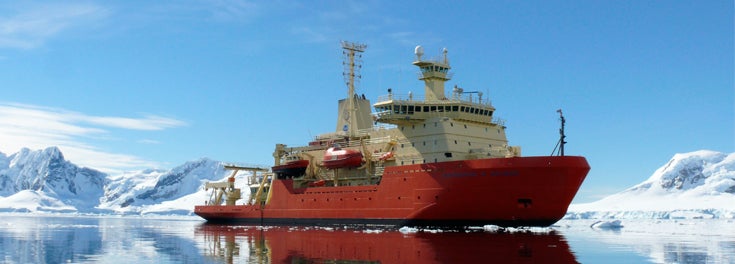
URI is once again breaking the ice—and breaking new ground.
A team of URI faculty and students returned in January from their second month-long research expedition to Antarctica. Their mission—to study the behavior of krill, the small crustaceans that play a pivotal role in the Antarctic food web. Traveling and living aboard the R/V Nathaniel B. Palmer, a 308-foot research ship with icebreaking capabilities, they conducted studies that had never before been attempted.
“We’re trying to learn what the krill are doing in the environment, their swimming and schooling patterns, and what prey they are eating,” said Ted Durbin, the URI Graduate School of Oceanography professor who led the expedition. “Krill are a keystone species in Antarctica. They are the primary diet of most penguins, seals and whales.”
We were in the Antarctic summer—it was incredible having sunshine all the time. and amazing to see the icebergs, mountains, and penguins every hour of the day.
“We need to understand what the krill eat,” added graduate student Alison Cleary, “because as the environment changes in Antarctica, what is available for them to eat may change, and that could affect all the other creatures up the food chain.”
There are a surprising number of unanswered questions about krill behavior and movement patterns, including the timing of their migrations and what they feed on during the dark winter months. So the research team used three-dimensional camera systems to examine krill swimming behaviors, conducted feeding studies of krill in a ship-based laboratory, and calculated how much they eat and what species of prey they prefer in the wild.
“I learned a lot about ship operations and all of the work that goes into field research,” said Jessica Perreault, a senior marine biology major. “Assimilating to the new work environment definitely took some patience and hard work, but I can honestly say I’ve never worked with a better mix of students and professors.”
It wasn’t all work and no play. The group enjoyed stunning views of the mountainous terrain along the coast, observed penguins, whales, and seals of many varieties, and spied massive icebergs everywhere they turned.
“Hands down, the best day of the entire cruise was Christmas Eve, when we went ashore at an Argentinean research station,” Jessica said. “It was a breathtaking spot where we spent a few hours exploring and getting to know the locals—the penguins. It was an incredible experience, especially considering that we hadn’t set foot on land in four weeks.”
For Alison, who had participated in research expeditions to Antarctica twice before, the difference between the summer and winter cruises were literally like night and day. “This year we were in the Antarctic summer—it was incredible having sunshine all the time, and amazing to see the icebergs, mountains, and penguins every hour of the day.”
